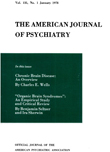PROGNOSES AND PSYCHOLOGICAL SCORES IN ELECTROCONVULSIVE THERAPY, PSYCHOSURGERY, AND SPONTANEOUS REMISSION
Abstract
1. The rate of improvement between ECT and ECT controls is not significantly different. There is a similarity between the psychological pretesting structure of both the improved ECT populations (those who were shocked and improved and those who improved spontaneously).
2. Patients undergoing lobotomy show the highest correlations between pretest scores and ratings of clinical improvement. Tests of memory and abstraction are especially important in this group.
3. Certain tests of memory, abstraction, and motor function were found to yield significant biserial coefficients of correlation for all clinical groups except lobotomy control patients. Of the Rorschach signs studied, only the number of rejections was found to yield consistently significant chi-squares for all clinical groups.
4. Study of the rationale of the most predictive tests indicates that common elements exist between them that should be further explored.
5. The findings of this paper suggest that the psychological test structure of patients be carefully scrutinized either before they are made to undergo treatment or before they are considered poor candidates for treatment procedures.
Access content
To read the fulltext, please use one of the options below to sign in or purchase access.- Personal login
- Institutional Login
- Sign in via OpenAthens
- Register for access
-
Please login/register if you wish to pair your device and check access availability.
Not a subscriber?
PsychiatryOnline subscription options offer access to the DSM-5 library, books, journals, CME, and patient resources. This all-in-one virtual library provides psychiatrists and mental health professionals with key resources for diagnosis, treatment, research, and professional development.
Need more help? PsychiatryOnline Customer Service may be reached by emailing [email protected] or by calling 800-368-5777 (in the U.S.) or 703-907-7322 (outside the U.S.).



